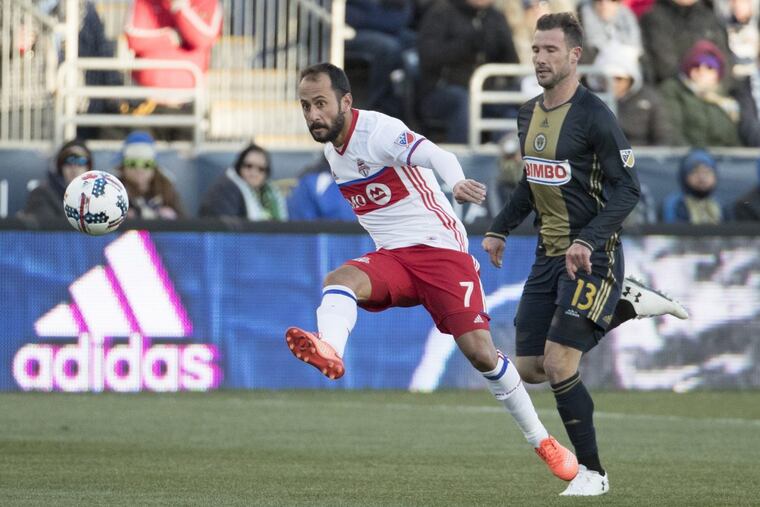As soccer analytics improve, is a wins above replacement statistic possible?
The statistic has become widely used in baseball and other sports. Analytics experts wonder if it can work in a sport as fluid and diverse as soccer.

While many of the United Soccer Coaches convention's 12,000 delegates were making their way toward the Convention Center last Wednesday, a smaller gathering was taking place on the other side of City Hall.
This one didn't get much advance promotion or hype. You wouldn't have known it was going on unless you paid really close attention to social media, and even then, there wasn't much chatter about it.
That was on purpose.
Opta, the soccer analytics company that fuels live stats for leagues around the world, hosted an event to discuss the increasing use of analytics in MLS, in the NWSL and worldwide. Almost all of the day's proceedings were off the record, because some presentations included clubs' proprietary data.
But there was also an understanding in the room that soccer analytics are being used more and more by the public. You've seen it most prominently with the expected goals statistic, which uses formulas to show not just how many chances a team has in a game, but also how good they are.
The metric can easily be converted into a graphical shot chart, which has led to its use on social media and MLS' national TV broadcasts.
"It's a very graphic-friendly stat, and I think seeing it makes it easier to understand if you're not as mathematically minded," ESPN soccer stats guru Paul Carr said. "If you have a visual, it gives you a better way to say it, and you can reach people in different and better ways."
Beyond expected goals (or xG for short), soccer can be a very difficult sport to turn into statistics. It isn't a series of individual events like football or baseball, and there isn't as high a volume of shots, assists, turnovers and so on as there is in basketball and hockey.
There is a definite desire to quantify what happens in a soccer game, though, and Opta has led the charge. If you look at a box score on Major League Soccer's website, for example, you'll see charts that track every touch, shot, tackle and run down the field a player makes.
Fans, media members and teams are clearly interested in finding new ways to view an old sport.
"There is obviously an effort in order to evaluate how players contribute to wins, and players replacing other players in order to evaluate scouting [and] team and match analysis," said Oliver Miller-Farrell, Opta's director of business development in North America.
Miller-Farrell and others in the soccer analytics community are especially interested in whether the sport can have a version of Wins Above Replacement, a statistic that has become widely used in baseball and other sports. The subject was one of the big talking points at Opta's seminar.
Some soccer clubs have their own proprietary ways of measuring WAR in players they scout and develop. But there isn't a widespread, publicly used standard as there is for baseball.
And there might not be for a while, because there are as many variables off the field in soccer as there are on it — and perhaps more.
"How do we approach different positions in the game? How we do evaluate defenders and their contributions to wins?" Miller-Farrell said. "Obviously, attackers are a lot more straightforward. But there are even challenges there. There's no one type of attacker, one type of goal-scorer. Everyone kind of contributes to the game in many different ways. … There's not one way to win a soccer game."
Then consider this: Who, exactly, is the "replacement" player replacing? For example, many English Premier League teams use their top players in league and European tournament games, but mostly play reserves in the FA Cup and Carabao (League) Cup. Should a "replacement" benchmark incorporate all of those competitions at once, or just individual ones?
"That's a unique and rare issue and problem in soccer, whereas baseball is one competition and very singular," Miller-Farrell said.
Making WAR work in MLS will be tricky too, even though teams don't play in as many competitions. How can you judge the replacement value of a European or South American player you've watched on tape in another league against an academy prospect or college-bred draft pick?
"That's absolutely a problem," Miller-Farrell said. "I think what's also important to recognize is even if we do achieve some sort of wins above replacement [statistic] or anything of that sort, it's really important that we recognize the limitations that will come with that. … There's always going to be a combination of subjective analysis and objective analysis."
Miller-Farrell and his colleagues embrace the challenge, though. Perhaps soccer will never get all the way to a WAR statistic and standard that's widely accepted, but it's a great goal to have.
And if, as Miller-Farrell offered, a soccer WAR statistic "is more enticing for a fan than it is applicable for a professional team or an analysis department," he won't mind that, either.
"It just gives you a different perspective for not only fans, but equally [broadcast] producers, talent and the people that are delivering it to fans," he said. "No one wants us to just put expected goals out there for the reasons of putting expected goals out there. We truly believe that it's something that can add to the storytelling and commentary of the game, and that's why we want to drive it."